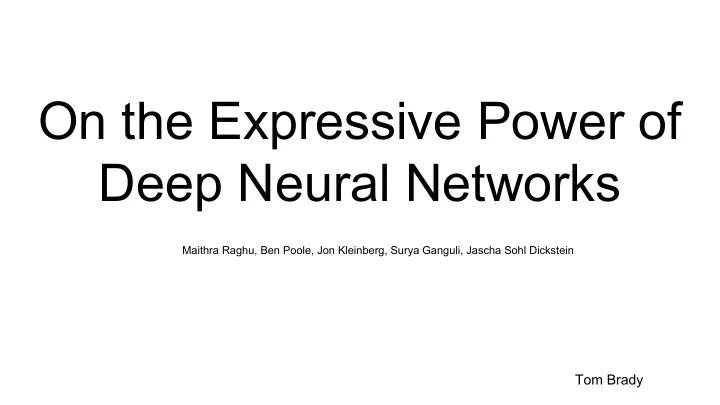

On the Expressive Power of Deep Neural Networks Maithra Raghu, Ben Poole, Jon Kleinberg, Surya Ganguli, Jascha Sohl Dickstein Tom Brady
Deep Neural Networks ● Recent successes in using Deep neural networks for image classification, reinforcement learning etc. f( ) = cat
But why do they work? ● Lack of theoretical understanding of the functions a Deep Neural network is able to compute ● Some work into shallow networks ○ Universal approximation results (Hornik et al., 1989; Cybenko, 1989) ○ Expressivity comparisons to boolean circuits (Maass et al., 1994) ● Some work into deep networks ○ Establishing lower bounds on expressivity ■ E.g. Pascanu et al., 2013; Montufar et al., 2014 ○ But previous approaches use hand-coded constructions of specific network weights ○ Functions studies are unlike those learned by networks trained in real life ● Lacking: ○ Good understanding of “typical” case ○ Understanding of upper bounds ■ Do existing constructions approach the upper bound of expressive power of neural networks?
Contributions ● Measures of expressivity to capture expressive power of architecture ● Activation Patterns ○ Tight upper bounds on the number of possible activation patterns ● Trajectory length ○ Exponential growth in trajectory length as function of depth of network ○ small adjustments in parameters lower in the network can result in large changes later ○ Trajectory Regularization ● Batch normalization works to reduce trajectory length ● Why not directly regularize on trajectory length?
Expressivity ● Given architecture A, associated function ● Goal: ○ How does this function change as A changes for values of W encountered in training, across inputs x ● Difficulty: ○ High dimensional input, quantifying F over input space is intractable ● Alternative: ○ Study one dimensional trajectories through input space
Trajectory Some trajectories: ● Line x(t) = tx1 + (1 - t) x0 ● Circular arc x(t) = cos(πt/2)x0 + sin(πt/2)x1 ● May be more complicated, and possibly not expressible in closed form
Measures of Expressivity: Neuron Transitions ● Given network with piecewise linear activations (e.g. ReLU, hard tanh), the function it computes is also piecewise linear ● Measure expressive power by counting number of linear pieces ● Change in linear region caused by a neuron transition ○ transitions between inputs x, x + δ if activation switches linear region between x and x + δ. ○ E.G. ReLU from off to on or vice versa ○ Hard tanh from -1 to linear middle region to saturation at 1 ● For a trajectory x(t), can define as the number of transitions undergone by output neurons as we sweep the input along x(t)
Measures of Expressivity: Activation Pattern Activation pattern ● A String of length number of neurons from set ○ {0, 1} for ReLUs ○ {−1, 0, 1} for hard tanh ● Encodes the linear region of the activation function of every neuron, for an input x and weights W Can also define the number of distinct activation patterns as we sweep x along x(t) ● Measures how much more expressive A is over a simple linear mapping
Upper Bound for Number of Activation Patterns
Trajectory transformation exponential with depth ● Trajectory increasing with the depth of a network ● Image of the trajectory in layer d of the network ● Proved that For a fully connected work with ○ n hidden layers each of width k ○ Weights ∼ N(0, σw2/k) ○ Biases ∼ N(0, σb2 )
Number of transitions is linear in trajectory length
Early layers most susceptible to noise A perturbation at a layer grows exponentially in the remaining depth after that layer.
Early layers most important in training
Trajectory Regularization ● Higher trajectory, higher expressive ability ● But also more unstable ● Regularization seems to be controlling trajectory length Wrong axis labels →
Trajectory Regularization ● add to the loss λ(current length/orig length) ● Replaced each batch norm layer of the CIFAR10 conv net with a trajectory regularization layer
Contributions ● Measures of expressivity to capture expressive power of architecture ● Activation Patterns ○ Tight upper bounds on the number of possible activation patterns ● Trajectory length ○ Exponential growth in trajectory length as function of depth of network ○ small adjustments in parameters lower in the network can result in large changes later ○ Trajectory Regularization ● Batch normalization works to reduce trajectory length ● Why not directly regularize on trajectory length?
Conclusions ● This paper equips us with more formal tools for analyzing the expressive power of networks ● Better understanding of importance of early layers: how and why ● Trajectory regularization is an effective technique, grounded in notion of expressivity ● Further work needed investigating trajectory regularization ● Trajectory has possible implications for understanding adversarial examples
Recommend
More recommend